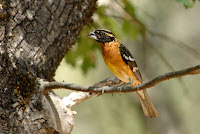BLACK-HEADED GROSBEAK
BLACK-HEADED GROSBEAK – (Pheucticus melanocephalus) – (See images below)
DESCRIPTION: The Black-headed Grosbeak male has black upper parts with white patches on the wings. Under-wings are yellow. Throat, neck, breast and flanks are deep orange. Belly is yellowish. Central under-tail is white. Large conical bill is dark grey. Eyes are black, legs and feet are grey. Female/juvenile have brown upper parts with white marks on the wings, and a yellowish superciliary line extending down the nape. There is also a fine light grey line in the middle of the head running from the bill base. Under parts are washed out orange-beige with fine brown streaks. Bird length is about 18 cm (7 inches).
VOICE: https://www.xeno-canto.org/species/Pheucticus-melanocephalus
NAME: “Grosbeak’ refers to the large bill size relative to the head. Latin genus name ‘Pheucticus’ means ‘painted with cosmetics’, in reference to the male breast color. Latin name ‘melanocephalus’ means ‘black head’.
HABITAT: Woodlands of various types (deciduous, mixed, etc.).
DIET: Seeds, insects, berries. One of the rare species to be able to eat Monarch butterflies in their wintering range in Mexico.
NESTING: Nest is a loose bowl-shaped structure built in a tree or shrub. It is sometimes so thin that eggs can be seen from under it. From three to five light blue-green eggs are laid, incubated by both parents, who also both feed the chicks.
DISTRIBUTION: Breeds in the southwest part of Canada, west half of the USA and north central Mexico. Winters in Mexico.
Distribution Map: https://en.wikipedia.org/wiki/Black-headed_grosbeak – /media/File:BlackHeadedGrosBeakMap2.JPG
ON PEI: Does not breed on Prince Edward Island, sightings listed as ‘accidental’ so far. See note below on bird vagrancy.
CONSERVATION: Widespread, not at risk.
NOTES: This grosbeak will hybridize with the Rose-breasted Grosbeak.
Vagrancy: In biology this means an animal going way outside its normal range. For birds, this can happen when there are storms and they get blown off course. On other times, the bird simply wanders in a different direction than usual. Here’s an article about vagrancy in birds.
SIMILAR SPECIES: Spotted Towhee, Baltimore Oriole
REFERENCES: https://www.audubon.org/field-guide/bird/black-headed-grosbeak http://fieldguide.mt.gov/speciesDetail.aspx?elcode=ABPBX61040 (Montana Field Guide)
https://animaldiversity.org/accounts/Pheucticus_melanocephalus/ (University of Michigan)
http://identify.whatbird.com/obj/73/overview/Black-headed_Grosbeak.aspx
https://birdatlas.mb.ca/accounts/speciesaccount.jsp?sp=BHGR&lang=en (Manitoba Breeding Bird Atlas)
DESCRIPTION: The Black-headed Grosbeak male has black upper parts with white patches on the wings. Under-wings are yellow. Throat, neck, breast and flanks are deep orange. Belly is yellowish. Central under-tail is white. Large conical bill is dark grey. Eyes are black, legs and feet are grey. Female/juvenile have brown upper parts with white marks on the wings, and a yellowish superciliary line extending down the nape. There is also a fine light grey line in the middle of the head running from the bill base. Under parts are washed out orange-beige with fine brown streaks. Bird length is about 18 cm (7 inches).
VOICE: https://www.xeno-canto.org/species/Pheucticus-melanocephalus
NAME: “Grosbeak’ refers to the large bill size relative to the head. Latin genus name ‘Pheucticus’ means ‘painted with cosmetics’, in reference to the male breast color. Latin name ‘melanocephalus’ means ‘black head’.
HABITAT: Woodlands of various types (deciduous, mixed, etc.).
DIET: Seeds, insects, berries. One of the rare species to be able to eat Monarch butterflies in their wintering range in Mexico.
NESTING: Nest is a loose bowl-shaped structure built in a tree or shrub. It is sometimes so thin that eggs can be seen from under it. From three to five light blue-green eggs are laid, incubated by both parents, who also both feed the chicks.
DISTRIBUTION: Breeds in the southwest part of Canada, west half of the USA and north central Mexico. Winters in Mexico.
Distribution Map: https://en.wikipedia.org/wiki/Black-headed_grosbeak – /media/File:BlackHeadedGrosBeakMap2.JPG
ON PEI: Does not breed on Prince Edward Island, sightings listed as ‘accidental’ so far. See note below on bird vagrancy.
CONSERVATION: Widespread, not at risk.
NOTES: This grosbeak will hybridize with the Rose-breasted Grosbeak.
Vagrancy: In biology this means an animal going way outside its normal range. For birds, this can happen when there are storms and they get blown off course. On other times, the bird simply wanders in a different direction than usual. Here’s an article about vagrancy in birds.
SIMILAR SPECIES: Spotted Towhee, Baltimore Oriole
REFERENCES: https://www.audubon.org/field-guide/bird/black-headed-grosbeak http://fieldguide.mt.gov/speciesDetail.aspx?elcode=ABPBX61040 (Montana Field Guide)
https://animaldiversity.org/accounts/Pheucticus_melanocephalus/ (University of Michigan)
http://identify.whatbird.com/obj/73/overview/Black-headed_Grosbeak.aspx
https://birdatlas.mb.ca/accounts/speciesaccount.jsp?sp=BHGR&lang=en (Manitoba Breeding Bird Atlas)
 |
| Black-headed grosbeak male, CA, by Alan Vernon |
 |
| Black-headed grosbeak female NM, by Peter Wallack |